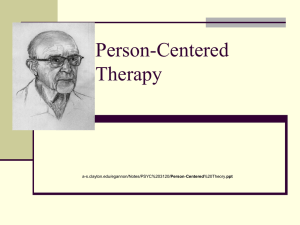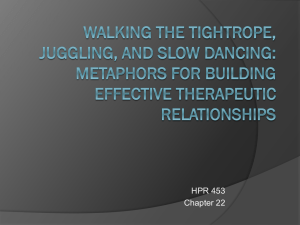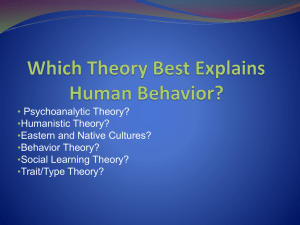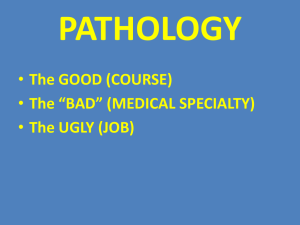Satir- Outline Humanistic perspective View of human nature Source
advertisement
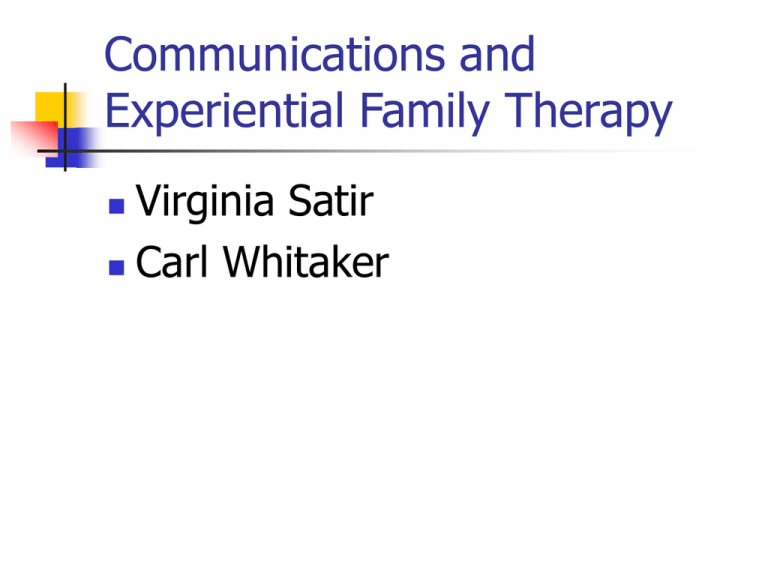
Communications and Experiential Family Therapy Virginia Satir Carl Whitaker Concepts to watch for: The Primacy of the experience – “Existence precedes essence,” “thoughts and feelings are attempts to understand our world, but the experience of life comes first.” Those who are only intellectualizing are not fully alive. Affect – Families who are not in touch with their experience and emotionally dead. Concepts to watch for: The Person of the Therapist – Experiential family therapists (all counselors) participate actively and personally in the session. They do not attempt to hide behind a therapeutic mask, but risk being vulnerable and open. Self-disclosure, and congruency and transparency are vital. Spontaneity and Creativity – non rational and creative experiences are important to provide for the family (client). Concepts to watch for: Freedom, Holism, and Existential Anxiety – Freedom – choice not fate, awareness of death, finality of life. I-Thou relationship – among family members and with the world, and starting with the therapist/client. Present-centeredness – Immediate experience and person-to-person encounters. Communications School Early MRI emphasized communications All behavior is communication Communication has both a Report and a Command Communication has both analogue and digital parts Meta communication is communication about communication. The double bind Two or more persons in an important relationship. Repeated experience. A primary negative injunction, such as “Don’t do X or I will punish you. A second injunction at a more abstract level conflicting with the first, also enforced by punishment or perceived threat. A tertiary negative injunction prohibiting escape and demanding a response Without this restriction the “victim” won’t feel bound; The complete set of ingredients is no longer necessary after the victim is conditioned. Existentialism Existentialism, a philosophy that examines the immediacy of the problems of life i.e., the condition of humans, the state of being free, and of having to use freedom in order to answer the ever-changing and unexpected challenges of the day. Existentialists have the starting point for every philosophical investigation as human existence -- the human personality itself, my “me,” your "you" -- whose drama of life, brought under critical analysis, should point the way to the absolute value of reality. Phenomenology – we all create and experience our own reality separate from what is real – out there. Search for meaning – we strive to understand what is all about. Satir- Outline Humanistic perspective View of human nature Source of motivation Development of pathology Nature of change Therapeutic relationship Satir- Humanistic Perspective Techniques Carl Rogers Fritz Perls Existentialists Satir- Humanistic Perspective Goal of humanistic therapy is to increase awareness of options and potential Make choices Increase autonomy and selfactualization Satir- Philosophical tenets Relationship is encounter between two people at any moment Strength of relationship based on strength of self-concept Satir- View of human nature Geared to survival, growth, getting close to others. Humans are limited in ways of “knowing” self Satir- Source of motivation Communication Self-worth Satir- Development of pathology Inability to form relationships. Ineffective communication Satir- Development of pathology Ineffective communicationConvey self incongruently Variable to adapt to present context Does not elicit feedback Denial of impulses Suppression of feelings Families are locked into self-protection and avoidance Emotional deadness Satir- Development of pathology Families are cold; tend to stay together out of habit or duty. Families lack warmth to themselves and others Couples live together in quiet desperation. Adults don’t seem to enjoy their children. Ineffective communication types Placater Blamer Computer Distractor Satir- Nature of change Goal of treatmentIncreased self-worth Clear, direct, honest communication Flexible and appropriate roles Open and hopeful links to society Satir- Therapeutic relationship Seen as resource person. Serve as experienced observer. Model good communication. Teach clients effective communication. Aware of possibilities for interactions in therapy Satir- Stages of therapy Opening phone call. Discover who is in family. Ages of members. Importance of members. Parenting roles Satir- Stages of therapy Initial sessionClarify family expectations Explain nature of family therapy Explore symptoms Reflect puzzlement of good intentions Family study Satir- Stages of therapy Family Life Chronology- (First 2 sessions) Courtship history Early married life Marital expectations Plan and arrival of each child Satir- Therapeutic relationship Emphasize equality in relationship Encourage client’s to elicit feedback from therapist Make “I value you” statements (well, we know you have good seed) Satir- Techniques Improve self-worthIdentify client strengths Ask questions on client’s area of expertise Note achievements in family history Accentuate good intentions Questions on bringing happiness to others Satir- Techniques Improve communicationDo not allow members to block communication Do not allow members to speak for each other Encourage client’s to ask for clarification Interpret family messages Satir- Stages of therapy TerminationComplete transactions, clear messages Improved perceptions of self, others perceptions Disagree Make choices Questions? Next Show film Carl Whitaker Whitaker- Philosophy Nontheoretical approach Moment-to-moment interchange Whitaker- Carl Whitaker’s View of human nature Healthy families: Process of perpetual becoming. Three generations that maintain autonomy. Flexible roles. Flexible power distribution Healthy families: Use constructive input. Develop “as if” structure. Allowed to be crazy. Develop functional realities Healthy families: Aware of stress of members. Express positive and negative feelings. Respect intimacy and separation. Encourage outside relationships Whitaker- Source of motivation Grow despite adversities. Parents grown from difficulties with their children. Deal with symptoms as growth Whitaker- Development of pathology Discomfort with growth. Inflexibility. Resistant to change. Whitaker- Nature of change Goal of therapy is to encourage change and growth Whitaker- Therapeutic relationship Use of co-therapists. Share opinions of family. Use of children as co-therapists. Model healthy adult functioning Whitaker-Stages of therapy Initial phone call-Insist on all members Whitaker- Stages of therapy Battle for structure. Therapists initially control structure of session, time, cost, location. Insist on all members present Whitaker- Stages of treatment Initial session. Address father first. Assess for subgroups Whitaker- Stages of therapy Battle for initiative Insist that family members make change Exchange control of sessions Whitaker- Stages of therapy Battle for bilaterality Family can leave treatment at any time Flight into health Whitaker- Techniques Redefinition of symptoms as growth. Use fantasy alternatives. Assign members to change roles. Augment despair of members. Engage in affective confrontation. Treat children like children. Separate interpersonal stress from fantasy stress. Highlight family revolution. Extended family reunion. Use of consultation Whitaker- Stages of treatment Termination Express feelings to family Questions? View film

